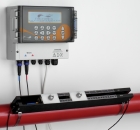Clamp-on flow meters monitor heating and water consumption

Excessively high energy consumption and an awareness of environmental considerations induced Northumbria University to monitor all campus boilers to find out how much energy was required to heat individual buildings and reduce downtime of heating and hot-water systems. The university called in Invisible Systems, which manufactures wireless energy-monitoring and control software and hardware.
A bespoke software program gathers all available data from the boilers and displays information that enables buildings to operate in an environmentally friendly way.
A site’s operational consumption is made visible, highlighting where energy use can be reduced and where costs can be saved.
As part of the projects, Vahid Tambe, Invisible Systems’ technical director, chose the Micronics U3000 ultrasonic flow meter (pictured) and Calec ST Modbus to help calculate usage and control the boilers more efficiently.
Vahid Tambe explains, ‘The U3000 proved to be simple to install as we didn’t need any specialist skills or tools. It just clamps onto the pipe, and then we connected the power and simply entered the pipe’s diameter.’ As such, Micronics flowmeters are a cost-effective alternative to in-line meters.
The university plans to install more Micronics flowmeters, particularly where it needs to know how much energy is used in buildings that are partly owned by the university and partly by a major supermarket chain.







